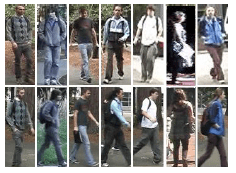Social Media Analytics
Occupation Recognition


Introduction
In this work, we investigate the problem of recognizing occupations of multiple people with arbitrary poses in a photo. Previous work utilizing single person’s nearly frontal clothing information and fore/background context preliminarily proves that occupation recognition is computationally feasible in computer vision. A more challenging task is recognizing occupation of multiple people with arbitrary poses in a photo. To that end, we propose to use discriminant clothing features and demographics, as well as structure classifiers for occupation recognition. To evaluate our method’s performance, we conduct extensive experiments on a new well-labeled occupation database with 14 representative occupations and over 7K images. Results on this database validate our method’s effectiveness and show that occupation recognition is solvable in a more general case.
Related Work
- Ming Shao, Liangyue Li, and Yun Fu, What Do You Do? Occupation Recognition in a Photo via Social Context, International Conference on Computer Vision (ICCV), pages 3631–3638, 2013. [pdf] [bib]
- Ming Shao, Liangyue Li, Yun Fu, Predicting Professions through Probabilistic Model under Social Context, AAAI Conference on Artificial Intelligence (AAAI), pages 122–124, 2013. [pdf] [bib]
Human Reidentification


Introduction
Person re-identification plays an important role in many safety-critical applications. Existing works mainly focus on extracting patch-level features or learning distance metrics. However, the representation power of extracted features might be limited, due to the various viewing conditions of pedestrian images in complex real-world scenarios. To improve the representation power of features, we learn discriminative and robust representations via dictionary learning in this paper. First, we propose a Cross-view Dictionary Learning (CDL) model, which is a general solution to the multi-view learning problem. Second, we propose a Cross-view Multi-level Dictionary Learning (CMDL) approach based on CDL. CMDL contains dictionary learning models at different representation levels, including image-level, horizontal part-level, and patch-level. Third, we incorporate a discriminative regularization term to CMDL, and propose a CMDL-Dis approach which learns pairs of discriminative dictionaries in image-level and part-level. We devise efficient optimization algorithms to solve the proposed models. Finally, a fusion strategy is utilized to generate the similarity scores for test images. Experiments on the public VIPeR, CUHK Campus, iLIDS, GRID and PRID450S datasets show that our approach achieves the state-of-the-art performance.
Related Work
- Sheng Li, Ming Shao, and Yun Fu, Person Re-identification by Cross-View Multi-Level Dictionary Learning, IEEE Transactions on Pattern Analysis and Machine Intelligence (TPAMI), 2017 (in press). [pdf]
- Sheng Li, Ming Shao, and Yun Fu, Cross-View Projective Dictionary Learning for Person Re-identification, International Joint Conferences on Articial Intelligence (IJCAI), pages 2155–2161, 2015. [pdf] [bib]
